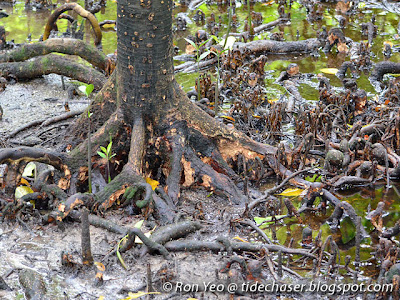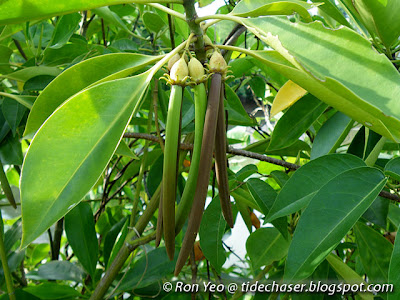The Bakau Putih (Bruguiera cylindrica) is a nationally common mangrove tree from the family Rhizophoraceae. This is, in fact, probably the most common mangrove tree in Singapore.
It is commonly found in most, if not all, the mangrove forests of Singapore. It usually occurs on firm clay at the seaward side of mangrove forests, usually behind the the more salt tolerant species.
The trunk is greyish brown in colour with small lenticels for gas exchange. Mature plants may have small buttress roots at the base of the trunk. The roots radiating from the tree somewhat loop above and below ground, forming knee roots. These roots help the plant breathe air, which is scarce in the waterlogged soil. The roots spread over a wide area to help stabilise the tree on the unstable ground. Like other mangrove species from the family Rhizophoraceae, B. cylindrica relies on its roots to exclude salt from entering the plant through a process called ultrafiltration.
It has simple, opposite leaves that are elliptic with pointed tips, clustering towards the end of the branch.
The small flowers are white and turn brown quickly, and each petal lobe has 2-3 bristles. The calyx is claw-like.
Vivipary is observed in this plant, as with the other mangrove species from the family Rhizophoraceae. This is a condition whereby the embryo grows and break through the seed coat and the fruit wall while still attached to the parent plant. Hence, the long structures seen hanging from the trees are seedlings, not fruits. The calyx lobes bend upwards as the seedling matures, and the seedling itself is cylindrical and often curved.
The seedling is dispersed by water. It floats horizontally for a few weeks, during which the root (lower part) will absorb water and become heavier, eventually causing the seedling to tip and float vertically. As the tide goes down, the vertically-oriented seedling will sink into the mud or other suitable substrates. Most of the seedlings, however, end up being washed ashore or eaten by animals.
The wood is said to have an odour which repels fish, and hence is not used for making fish traps. It is used as firewood.
References
- Chong, K. Y., H. T. W. Tan & R. T. Corlett, 2009. A Checklist of the Total Vascular Plant Flora of Singapore: Native, Naturalised and Cultivated Species. Raffles Museum of Biodiversity Research, National University of Singapore. Singapore. 273 pp.
- Giesen, W., S. Wulffraat, M. Zieren & L. Scholten. 2006. Mangrove guidebook for Southeast Asia. RAP Publication 2006/07. FAO Regional Office for Asia and the Pacific & Wetlands International. Bangkok. 769 pp.
- Ng, P. K. L. & N. Sivasothi. 1999. A guide to the mangroves of Singapore 1 : the ecosystem & plant diversity. Singapore Science Centre. Singapore. 168 pp.

No comments:
Post a Comment